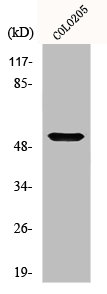OPN4 Antibody
-
货号:CSB-PA003226
-
规格:¥880
-
图片:
-
其他:
产品详情
-
Uniprot No.:Q9UHM6
-
基因名:
-
别名:OPN4; MOP; Melanopsin; Opsin-4
-
宿主:Rabbit
-
反应种属:Human
-
免疫原:Synthesized peptide derived from the C-terminal region of Human Melanopsin.
-
免疫原种属:Homo sapiens (Human)
-
标记方式:Non-conjugated
-
抗体亚型:IgG
-
纯化方式:The antibody was affinity-purified from rabbit antiserum by affinity-chromatography using epitope-specific immunogen.
-
浓度:It differs from different batches. Please contact us to confirm it.
-
保存缓冲液:Liquid in PBS containing 50% glycerol, 0.5% BSA and 0.02% sodium azide.
-
产品提供形式:Liquid
-
应用范围:WB, IF, ELISA
-
推荐稀释比:
Application Recommended Dilution WB 1:500-1:2000 IF 1:200-1:1000 ELISA 1:5000 -
Protocols:
-
储存条件:Upon receipt, store at -20°C or -80°C. Avoid repeated freeze.
-
货期:Basically, we can dispatch the products out in 1-3 working days after receiving your orders. Delivery time maybe differs from different purchasing way or location, please kindly consult your local distributors for specific delivery time.
相关产品
靶点详情
-
功能:Photoreceptor that binds cis-retinaldehydes. Contributes to pupillar reflex, photoentrainment and other non-image forming responses to light. May be involved in the optokinetic visual tracking response. May be involved in the regulation of retinal hyaloid vessel growth and regression.
-
基因功能参考文献:
- Valuable insight into the structure-function relationships of human melanopsin, including several key functional residues of the melanopsin protein. The identification of melanopsin variants with significantly altered function may serve to detect individuals with disrupted melanopsin-based light perception, and potentially highlight those at increased risk of sleep disturbance, circadian dysfunction, and visual disorders. PMID: 29700553
- The wide distribution of OPN4 in central areas of the human brain evokes a question whether ambient light has important straight targets in the human brain outside the retinohypothalamic tract. PMID: 27690288
- Trait-like individual differences in the melanopsin phototransduction circuitry contribute to individual differences in sleep timing. Blue light-sensitive young individuals are more prone to delayed sleep. PMID: 27091519
- The light-induced FOS response in melanopsin expressing HEK-293 cells is correlated with melanopsin quantity and dependent on light duration and irradiance. PMID: 24909488
- By broadening the tuning of intrinsically photosensitive retinal ganglion cells, melanopsin tristability produces signal integration. PMID: 25741728
- The response of the human pupil to the separate stimulation of the cones and melanopsin at a range of temporal frequencies under photopic conditions, was measured. PMID: 25313040
- Studied OPN4*Ile394Thr gene polymorphism in association with sleep/wake timing. PMID: 24887407
- The results of this study showed that the post illumination pupil response varied on the basis of OPN4 I394T genotype among individuals with seasonal affective disorder. PMID: 23809464
- Studied the association between melanopsin gene polymorphism and pupillary light reflex under diverse photic conditions, including different intensities and wavelengths. PMID: 24119231
- A comparison of melanopsin with the mechanisms documented for vertebrate (bovine) and invertebrate (squid) visual photoreceptors shows that such a mechanism is not affected by the diversity of the three chromophore cavities. PMID: 24449866
- Significant interaction between the genotype of I394T (TT versus TC+CC) and luminance levels was found in pupil size. PMID: 23555953
- An action spectrum for the calcium response in cells expressing human melanopsin had the predicted form for an opsin : vitamin A1 pigment and peaked at 479 nm. The G-protein selectivity and spectral sensitivity of human melanopsin is similar to that previously described for rodents. PMID: 23554393
- the results indicate that ectopic expression of human OPN4 in orexin neurons enables long-lasting activation of orexin neurons by blue light to control sleep/wakefulness of the mice. PMID: 22868039
- These results suggest that the P10L TT genotype of melanopsin interacts with daylength to predispose individuals to vary in sleep onset and chronotype as a function of daylength. PMID: 22881342
- The relative contribution of melanopsin and visual photoreceptors are assessed by comparing pupillary light reflex responses in a totally visually blind patient with normally sighted individuals. PMID: 23055493
- Melanopsin and mechanisms of non-visual ocular photoreception PMID: 22074930
- The recent advances in the emerging roles of melanopsin and intrinsically photosensitive retinal ganglion cells, are reviewed. PMID: 20810319
- melanopsin acts as a sensory photopigment, coupled to a native ion channel via a G-protein signalling cascade, to drive physiological light detection PMID: 15674244
- an anatomically distinct population of 'giant', melanopsin-expressing ganglion cells in the primate retina that, in addition to being intrinsically photosensitive, are strongly activated by rods and cones PMID: 15716953
- Regulation of melanopsin expression [review] PMID: 16687290
- HEK293 cells stably expressing melanopsin have proven to be a useful tool to study melanopsin-initiated signaling. PMID: 16961436
- Data show that Seasonal Affective Disorder participants have a higher frequency of the melanopsin (OPN4) homozygous minor genotype (T/T) for the missense variant rs2675703 (P10L) than controls, compared to the combined frequencies of C/C and C/T. PMID: 18804284
显示更多
收起更多
-
亚细胞定位:Cell membrane; Multi-pass membrane protein. Cell projection, axon. Cell projection, dendrite. Perikaryon.
-
蛋白家族:G-protein coupled receptor 1 family, Opsin subfamily
-
组织特异性:Expressed in the retina.
-
数据库链接:
HGNC: 14449
OMIM: 606665
KEGG: hsa:94233
STRING: 9606.ENSP00000361141
UniGene: Hs.283922
Most popular with customers
-
-
YWHAB Recombinant Monoclonal Antibody
Applications: ELISA, WB, IF, FC
Species Reactivity: Human, Mouse, Rat
-
Phospho-YAP1 (S127) Recombinant Monoclonal Antibody
Applications: ELISA, WB, IHC
Species Reactivity: Human
-
-
-
-
-






















